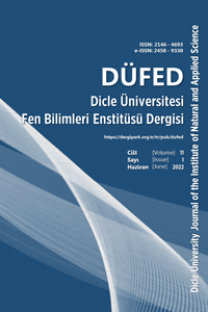Böcek paraziti nematod, Steinernema feltiae Rhabditida: Steinernematidae nin dikey dağılımı üzerine toprak solucanlarının etkisi
Böcek paraziti nematod, Steinernema feltiae’nin dikey dağılımı toprak kolonlarda, toprak solucanları ile test edilmiştir. Bu toprak solucanlarından birisi gri toprak solucanı Aporrectodea caliginosa, diğeri ise kırmızımsı-kahve renkli toprak solucanı Lumbricus rubellus’dur. Nematodun dikey dağılımı 3 haftalık bir period sonrası değerlendirilmiştir. S. feltiae büyük mum güvesi, Galleria mellonella’nın son evresinde yetiştirilmiştir. S. feltiae’nin dikey dağılımı toprak solucanlarının mevcudiyetinde artış göstermiştir. Bu hareket için, L. rubellus, A.caliginosa’dan daha etkili olmuştur
The effect of earthworms on vertical dispersal of entomopathogenic nematode, Steinernema feltiae Rhabditida: Steinernematidae
Vertical dispersal of the entomopathogenic nematode, Steinernema feltiae was tested with earthworms in soil columns. One of them is grey worm, Aporrectodea caliginosa and the other is reddish-brown worm, Lumbricus rubellus. Nematode vertical dispersal was estimated after a 3-week period. S. feltiae reared in the last instar of the greater wax moth, Galleria mellonella. Vertical dispersal of S. feltiae was increased in the presence of earthworms. For this motion, L. rubellus is more effective than A.caliginosa
___
N. Ishibashi, E. Kondo. Behavior of infective juveniles Pp. 139-150 in R. Gaugler and H. K. Kaya eds. Entomopathogenic Nematodes in Biological Control. Boca Raton, FL: CRC Press (1990).M.J. Downes, C.T. Griffin. Dispersal behaviour and transmission strategies of the entomopathogenic nematodes Heterorhabditidae and Steinernematidae. Biocontrol 6: 347-356 (1991).
H.K. Kaya, R. Gaugler. Entomopathogenic nematodes. Annual Review of Entomology 38: 181-206 (1993).
R.F. Denno, D.S. Gruner, I. Kaplan. Potential for entomopathogenic nematodes in biological control: a meta-analytical synthesis and insights from trophic caucade theory. Journal of Nematology 40: 61-72 (2008).
N.D. Epsky, D.E. Walter, J.L. Capinera. Potential role of nematophagous microarthropods as biotic mortality factors of entomogenous nematodes (Rhabditida: Steinernematidae, Heterorhabditidae). Journal of Economic Entomology 81: 821-825 (1988).
G. Georgis, R. Gaugler. Predictability in biological control using entomopathogenic nematodes. Journal of Economic Entomology 84: 713-720 (1991).
H.K. Kaya. Soil ecology. Pp. 93-115 in R. Gaugler and H.K. Kaya, eds. Entomopathogenic nematodes in biological control. Boca Raton, FL: CRC Press (1990).
Q.L. Wang, J.Y. Cui, Z.X. Li, C.Q. Liu. Effect of soil moisture on the motion of Steinernema glaseri (Nematoda: Steinernematidae). Chinese Journal of Biological Control. 11: 150-152 (1995).
K.E. Lee. Earthworms: Their ecology and relationship with soils and land use. Sydney, Australia: Academic Press (1985).
M. Mısırlıoğlu. Toprak solucanları biyolojileri, ekolojileri ve Türkiye türleri. Nobel Yayın Dağıtım 104s. (2011).
A.S. Molyneux, R.A. Bedding. Influence of soil texture and moisture on the infectivity of Heterorhabditis sp. D1 and Steinernema glaseri for larvae of the sheep blowfly Lucilia cuprina. Nematologica 30: 358-365 (1984).
D.I. Shapiro, E.C. Berry, L.C. Lewis. Interaction between nematodes and earthworms: Enhanced dispersal of Steinernema carpocapsae. Journal of Nematology 25: 189- 192 (1993).
P. Timper, H.K. Kaya, R. Gaugler. Dispersal of the entomogenous nematode Steinernema feltiae (Rhabditida: Steinernematidae) by infected adult insects. Environmental Entomology 17: 546-550 (1988).
T.J. Walker. Mole crickets in Florida. Florida Agricultural Experimental Bulletin, No. 845. 54 pp. (1984).
R.J. Zimmerman, R.J, W.S. Cranshaw. Short- term movement of Neoaplectana spp. (Rhabditida: Steinernematidae) and Heterorhabditis “HP 88 strain (Rhabditida: Heterorhabditidae) through turfgrass thatch. Journal of Economic Entomology 84: 875-878 (1991).
- ISSN: 2146-4693
- Yayın Aralığı: Yılda 2 Sayı
- Başlangıç: 2012
- Yayıncı: Dicle Üniversitesi
Sayıdaki Diğer Makaleler
Birecik Kelaynak Kuşlarında Geronticus eremita Üreme Başarısı-2013
Ayman ELSABAGH, Abd Elhamid OMAR, Hirofumi SANEOKA, Celaleddin BARUTÇULAR
Sertaç TEKDAL, Mehmet YILDIRIM
Tek Melez Mısır Genotiplerinin Diyarbakır Şartlarındaki Performanslarının Belirlenmesi
Şerif KAHRAMAN, Şehmus ATAKUL, Sevda KILINÇ
Türkiye'de badem yetiştiriciliğinin durumu ve yapılan seleksiyon çalışmaları konusunda bir araştırma
